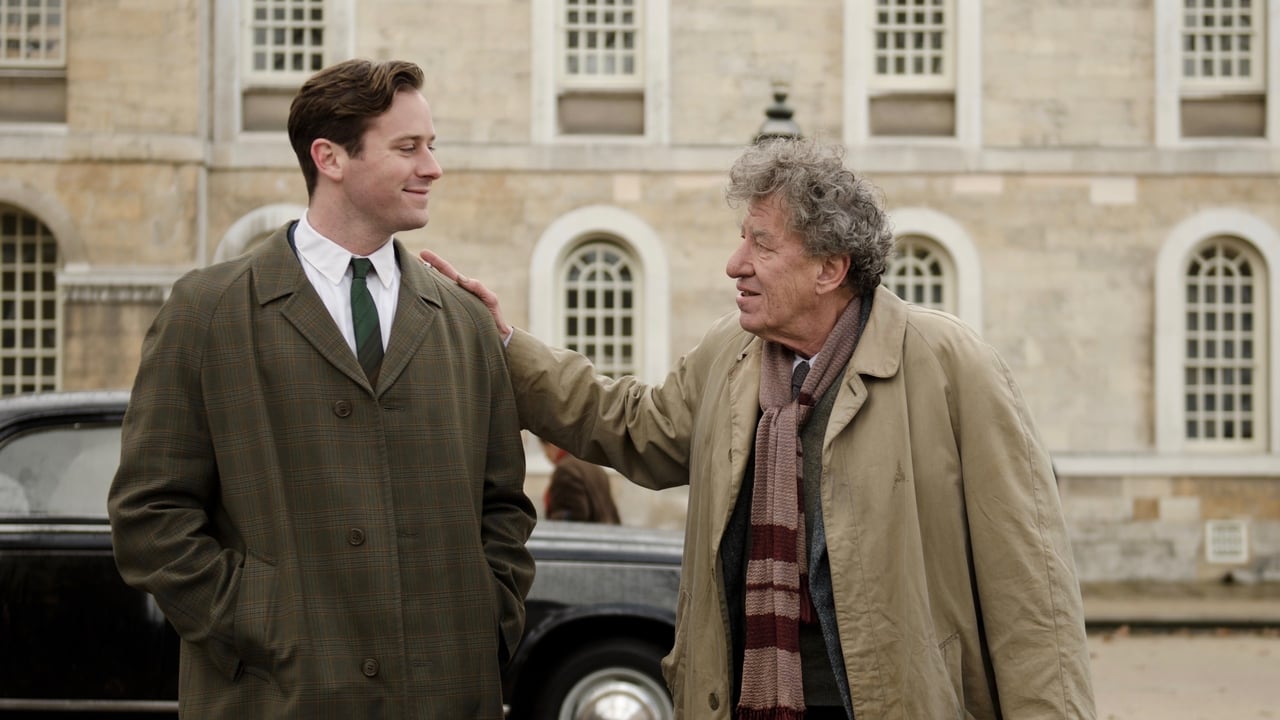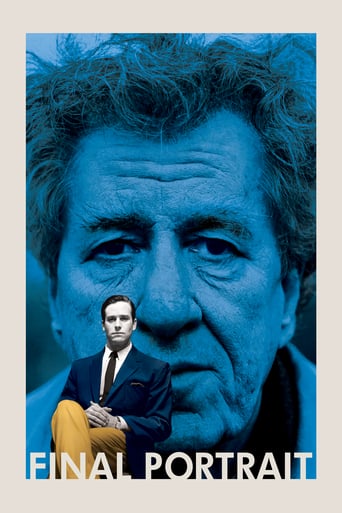

Like most films about an artist, this is about (i) this artist and (ii) The Artist. This artist is the brilliant Swiss/Italian painter/sculptor Alberto Giacometti. Among the several borders he straddles in his work is mankind/existence. His characteristic image - whether in litho, painting or sculpture - is of an impossibly emaciated being, elongated into a teetering vulnerability. His figurative skeletons barely sustain their fragile presence in the antipathetic universe. But they stolidly strive on, with a burning eye or an assertive stride. Yet they barely impinge on their space. That encapsulates postwar European existentialism. The figures are not thin from dieting or starvation but from having been buffeted down and encased by the strictures of human existence. The film recreates Giacometti's studio which teems with recreations of his work. One large white head, bulkier than his typical, looms like a judgment as the characters engage around it and as the artist continually tinkers with his other pieces. Art big, a life small, that one silently asserts. With very little in the way of plot, action, even events, the film's focus is on characterizing Giacometti. The drama his subject James Lord records is Giacometti's insatiable dissatisfaction with his own work. The portrait that should take a day or two stretches into weeks as the artist finds one sense of failure after another, continually whiting over his work to begin anew. What anyone else might deem a success in form and expression, he dismisses because it doesn't achieve his non-apprehensible ideal. A nut bar, obviously, aka Artist. To appease the artist, Lord again and again postpones his flight to New York, even at the risk of the relationship he is compromising by his delays. This Giacometti lives large, everything with a flourish, from his assertive shabbiness to his exaggerated "depositing" of his money. The paradox is that the artist is so effusive in his life but makes such sucked-in, suppressed, creatures in his art. In life he flaunts the obtrusive self, while his art reflects our existential limitations. The two visions respond to each other. Even as he prepares to do a new work or as he rushes out to a bar or a walk, he can't help stopping to do a quick improvement on another piece. And he can never be certain it's an improvement. For its very committing is human, and his own, so necessarily imperfect. Perhaps that's why his every intense day of living is shadowed by the urge to suicide. If only it didn't happen just once.... If only you could repeat it, to improve it.... His quest for that subjective perfection means he can never be satisfied. It also means he keeps growing, changing and taking more risks and achieving greater art. Because he can't be satisfied by his work or by himself, here he trades some of his current more valuable drawings for some earlier - less fashionable, less valuable - works, because he wants to recover something of his old, lost self. The gray old man finds his illusion of romance as fugitive as the vision he pursues in his art - and even more expensive. Hence his absurd overpayment of his mistress's pimps when they come to renegotiate their contract. He raises the price they ask and insists on giving them a large wad to cover the last six months and a larger one for the next. In sex as in art he staves off his mortality. That's living large when you feel human life is so small. For all this individualizing of Giacometti, the film also exercises the modern stereotype of the bohemian artist. Giacometti lives that flamboyance, overriding conventions of art, morality, marriage, social niceties, in compulsive assertion of his self. This is the modern romantic vision of the - of course, necessarily Male - artist. Typically, we get the artist's habitual abuse of his wife, whom he exploits, insults, betrays. Yet he lavishly spoils his mistress, buying her a sports car, and suffers her neglect without a word. You don't have to be of the Me, Too generation to be offended by this. But it helps. He knows the other major artists of his day, of course, but in his own mind and conversation jockeys through gossip to maintain his superiority. An artist needs an ego. How else could he dare to be original? On this theme the film establishes a pointed contrast between Alberto and his artist/designer brother Diego. (Of the lesser known brother Bruno we hear nothing.) Diego has the requisite sensitivity and imagination. He makes a beautiful bird but ruefully acknowledges "It can't fly." But in contrast to Alberto's standard-issue flamboyance, Diego is the quiet, self-effacing worker. He dresses in a shop manager's smock. Instead of the sweeping gesture or challenging extremity, Diego quietly fiddles with things, turning out stuff of value and beauty without any major claims for it. He also avoids Alberto's emotional extremes, indulgences and engagements. Diego's quiet persistence contrasts to Alberto's exuberance. There are other kinds of artist than the stereotype. But it's the Alberto that brings to our much later attention the Diego.
... View MoreI wanted to see this movie because I like Geoffrey Rush and Tony Shalhoub. I'd never seen a movie directed by Stanley Tucci, either, so that interested me. I took myself to see this, and expected a semi-art house flick. This was... OK, in my opinion. Here's why:The Good: The acting is good, which means the directing was good. Well acted and directed in my opinion.The Bad: There's a bit more than the good, unfortunately. The scenes get a little repetitive after a while, there's a dark color tone to the film that takes a little while to get used to, and I don't feel like you really have a reason to care about the characters. You get left in the dark, just kind of wondering what's taking so long for this man to finish the portrait. He's all over the place. Sometimes studying his drawing, sometimes carousing his mistress, sometimes cursing up a storm. It's an odd situation, watching this film. I didn't dislike it, as some of the other patrons in my theater did, but I don't see a reason to revisit it. So... I'll give it 5/10.
... View MoreI understand that there are people that may have problems with this movie. It can be a frustrating movie to watch. But it can also be, funny, exasperating and sad. The acting is great. I don't place a judgement on the artist's behavior. He was as he was. This movie is about the artistic process, and the collaboration in that process. It can be tedious, chaotic and at times mesmerizing. It reminded me of a few of my friends who are artists. They truly do see the world in a different way, and at times you just have to go with it.
... View MoreA simple well written and perfectly acted story of an artist and his need to create and make that creation perfect to his liking.Set in the early 1960's the feel and charm of this film is quiet and unrushed to show a time when daily life wasn't as complex and full of the communication distractions we are saddled with today.This story isn't so much about the artist as it is about the artist nearing his final days and facing his needs.Loved it !
... View More